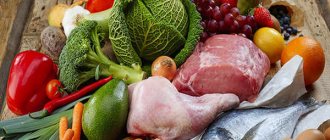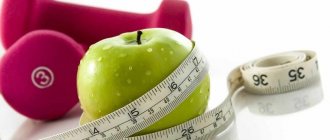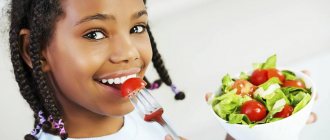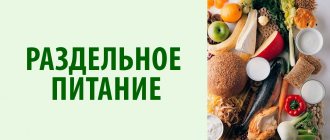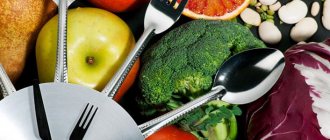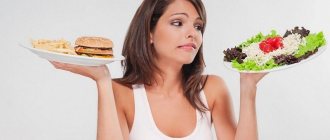General information
The problem of excess weight in the modern world is very relevant for a huge number of people.
In order to achieve the desired shape, people use different methods, ranging from various diets to taking special, often dubious drugs. However, it is usually possible to lose weight by following a particular diet only for a short period. In addition, an incorrect approach to nutrition often leads to very serious disorders in the body and disruptions in metabolic processes. As a result, a person can eat quite little, but still not lose weight, and sometimes even gain weight. To avoid this, the approach to catering must be correct. A balanced diet is the basis of health, well-being and a beautiful figure. This article describes the basic principles of a balanced diet and the correct approach to its organization.
Millet with pumpkin
This balanced breakfast option is a successful combination of cereals and sweet orange pulp. According to nutritionists, it is equally useful for both adults and children, which means it will definitely find its place in your menu.
To prepare this porridge you will need:
- 250 g pumpkin;
- 1 glass of water;
- 1 cup of millet cereal;
- salt and sugar (to taste).
- The washed and peeled pumpkin is freed from all excess and cut into pieces.
- Place in a suitable pan, add water and simmer over low heat.
- After about ten minutes it is supplemented with pre-sorted cereals, sugar and salt.
- All this is cooked until cooked and served.
Balanced Diet: The Basics
The theory of a balanced diet first appeared more than two hundred years ago. It was fully formed at the beginning of the twentieth century. This concept includes the following basic principles:
- Nutrition is a source of energy and helps maintain the molecular composition of the body.
- The ideal diet is when the nutrients entering the body correspond to their consumption in composition and time. That is, it is necessary to strive for such a scheme that the substances obtained from food accurately replace the elements that are consumed by the body.
- Nutrients enter the blood when food structures are destroyed and nutrients important for metabolic processes and satisfying plastic and energy needs are absorbed.
- The products contain a number of components that differ in their physiological significance: these are nutrients important for the body (fats, carbohydrates, proteins, vitamins, amino acids, water), ballast components and toxic substances.
- The value of products can be determined by the quantity and ratio of beneficial nutrients in them - monosaccharides, amino acids , a number of salts, vitamins, fatty acids. Metabolic processes depend on their level. There is a so-called monomer diet, when polymer food is replaced with products that include only elements involved in metabolic processes.
- The body itself utilizes food.
So, the “formula” of a balanced diet is as follows: the body must receive in a timely manner foods that contain the substances it needs in the correct proportions. They must provide energy expenditure, tissue renewal and regulate the metabolic .
The theory of balanced nutrition was the basis for the development of food diets for people, taking into account various characteristics, for the creation of new food technologies, etc.
It was also the basis for the creation of parenteral (intravenous) nutrition, which is now used for treatment.
Muesli with fruit and yogurt
This recipe is sure to be in the treasury of lovers of quickly prepared dishes. To play it you will need:
- 100 g muesli;
- 250 g natural yogurt;
- 100 ml orange juice;
- any nuts and fruits.
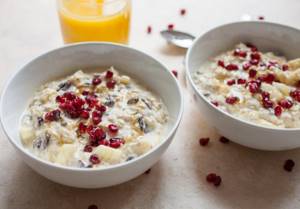
According to reviews, you will have to spend very little time preparing such a balanced breakfast. Therefore, you don’t have to get up at five in the morning to feed your family delicious and healthy food:
- Peeled and washed fruits are cut into small pieces and combined with any processed nuts.
- All this is poured with a mixture of yogurt and citrus juice, and then complemented with muesli and served almost immediately.
Balanced diet for weight loss
A complete and at the same time maximally balanced menu can become the basis for healthy weight loss and help you lose excess weight without disturbing the condition of the body.
A healthy, balanced diet for weight loss requires adherence to a number of important principles:
- It is important that the menu has the correct ratio of proteins, carbohydrates and fats. According to most nutritionists, the most optimal combination of nutrients for the body in the daily diet is: carbohydrates - 60%, fats - 30%, proteins - 10%. It is equally important to choose the right carbohydrate-containing foods. They should contain 75% starch, 20% lactose, fructose, sucrose, 5% pectin and fiber. As for proteins, most of them should be of animal origin. Also, of the total amount of fats, about a third should be vegetable.
- It is necessary to correctly divide the number of calories into meals. In this case, you need to divide food like this: for breakfast - 25% of the total daily calorie content, for lunch - 50%, for dinner - 25%. A special balanced nutrition calculator, which can be found on specialized websites, as well as calorie tables will help you correctly formulate a specific menu. You should also pay attention to the calorie information on food labels.
- As for the total calorie content per day, it should not exceed 2400 kilocalories. And those who want to lose weight should reduce this figure to 1800 calories.
- Drink enough water. To determine the correct “dose” of water, women need to multiply their weight by 30 ml, men – by 35 ml.
- Practice physical activity regularly. Often nutritionists and fitness trainers recommend training two hours before dinner. This will help reduce your appetite in the evening.
- Avoid feeling hungry. In order for a person to feel comfortable and for metabolic processes to occur correctly, it is necessary to prevent severe hunger. When the body feels hungry, it will try to store as much fat as possible, so it will not be possible to lose weight. It is important that a person eats consistently, and food enters the stomach with a certain regularity, at least once every three hours. The last time you should eat is three hours before bedtime.
- Don't eat too large portions. One main meal should not consume a portion exceeding 300 g. Two additional snacks are also provided.
- You need to consume only natural and healthy food. We need to forget about fast food, snacks, soda, etc.
Apple-oat pancakes
This option is ideal for a children's menu. A balanced breakfast in the form of sweet pancakes, pleasantly smelling of fruits and honey, will be enjoyed by even the most picky kids who hate oatmeal. To make these pancakes you will need:
- 200 g apples;
- 30 g honey;
- 80 g oatmeal;
- 1 egg.
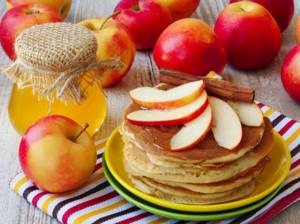
We prepare them like this:
- The washed and peeled apple is processed using a coarse grater.
- The resulting shavings are combined with an egg and ground oatmeal.
- Mix everything well and place it in portions on a non-stick frying pan.
- Fry covered for three minutes on each side.
- Before serving, the rosy pancakes are poured with liquid flower honey.
Balanced diet menu for weight loss
In order for a person to eat a balanced diet and at the same time lose weight, the menu should be dominated by low-calorie foods that contain a lot of fiber and dietary fiber. These are fresh fruits and vegetables, which, if possible, should be eaten unpeeled, lean meat and fish, seafood, bran, wholemeal bread, and low-fat dairy products. A good example of systematizing the important principles of a balanced diet is the food pyramid, which helps you understand what food should dominate the menu, and what food should be eaten as rarely as possible.
It is not necessary to consume vegetables and fruits raw. They can be steamed, baked, or grilled. True, during heat treatment, especially long-term, the amount of nutrients in fruits and vegetables is reduced. A balanced diet for weight loss should include cabbage, carrots, turnips, beets, zucchini, peppers, onions and various greens.
It is important to know that a balanced diet menu for weight loss includes many restrictions and exceptions. When creating a menu for weight loss, you need to limit:
- eggs - no more than three per week;
- sweet dishes and sugar – small portions of sweets can be eaten no more than twice a week.
The following are completely excluded from the menu:
- canned food;
- fried foods;
- any sausages;
- sauces – salad dressings, mayonnaise;
- fat meat;
- animal fats;
- fatty dairy products - butter, cheese, sour cream, ice cream;
- coffee, black tea, soda;
- alcohol.
Product replacement
Compared to diets that are strict and aggressive for the body, in a balanced diet the menu for every day is not static - foods in the diet can be safely replaced with similar ones (from the same food group).
Of course, you can’t eat an extra serving of pasta instead of vegetables, and cottage cheese instead of a banana. But it is quite possible to alternate different fruits (depending on personal preferences), choose other types of fermented milk products (except for sweet yoghurts and filled cheeses).

When to start a balanced diet?
Anyone who intends to switch to such a diet needs to realize that this is not about a diet, but about a certain lifestyle. Therefore, it is important to mentally prepare yourself for the transition to a healthier lifestyle. At the same time, it is worth not only starting the path to changing your own habits, but also introducing your loved ones to a balanced diet. After all, it is very important to correctly formulate a menu for children and adolescents so that schoolchildren’s nutrition is balanced.
It is better to introduce such changes to the family diet in the warm season, when there is a lot of fresh herbs, fruits, and vegetables.
For those who are trying to lose weight, it is better to start this process in late summer or early autumn. During the warm season, appetite decreases, and low-calorie fruits and vegetables are plentiful at this time.
Balanced diet for a week
You must adhere to the proposed diet throughout the diet. But even after its completion, the basic principles should be observed, removing too strict restrictions.
The menu by day of the week might look like this:
Monday
- Breakfast : egg, salad greens, bran toast.
- Snack : kefir or yogurt.
- Lunch : vegetable soup, green salad and tomato, diet bread.
- Afternoon snack : seasonal fruits.
- Dinner : boiled or baked fish, boiled rice.
- At night : kefir.
Tuesday
- Breakfast : oatmeal, boiled fish, toast with bran.
- Snack : bread with cottage cheese.
- Lunch : vegetable borscht, 100 g of boiled chicken fillet, cabbage and carrot salad.
- Afternoon snack : kiwi.
- Dinner : stewed beans with tomatoes, rye bread.
- At night : yogurt.
Wednesday
- Breakfast : low-fat cottage cheese casserole.
- Snack : orange or apple.
- Lunch : fish soup, stewed vegetables.
- Afternoon snack : seasonal fruits.
- Dinner : boiled or stewed vegetables, cottage cheese.
- At night : kefir.
Thursday
- Breakfast : buckwheat, cucumber.
- Snack : kefir.
- Lunch : steamed chicken cutlets, stewed vegetables.
- Afternoon snack : berries or apple.
- Dinner : cottage cheese, oatmeal.
- At night : yogurt.
Friday
- Breakfast : oatmeal with honey and nuts.
- Snack : banana.
- Lunch : baked sea fish, salad of celery, carrots and seaweed.
- Afternoon snack : orange or tangerines.
- Dinner : vegetable casserole with low-fat cheese.
- At night : kefir or fermented baked milk.
Saturday
- Breakfast : egg, bran toast, tomatoes or cucumbers.
- Snack : yogurt with fruit.
- Lunch : boiled beef, stewed vegetables, bread.
- Afternoon snack : apple, nuts.
- Dinner : buckwheat, boiled fish.
- At night : kefir.
Sunday
- Breakfast : pearl barley porridge, fresh vegetables.
- Snack : fermented baked milk.
- Lunch : stewed fish, rice, cucumbers.
- Afternoon snack : tomato juice, crackers.
- Dinner : vegetable stew without potatoes.
- At night : yogurt.
This diet is practiced for 2-3 weeks, after which the restrictions may no longer be so strict. However, if necessary, you can eat according to this example for longer, since this menu is quite balanced. To diversify the menu, you can use different dietary recipes that contain permitted foods.
Recipes for healthy breakfast, lunch and dinner
Food can be varied and tasty. The following three recipes will prove this:
- Healthy sandwiches for breakfast. The basis is whole grain bread. You can put the following variations of products on top of it: peanut butter with banana or strawberries, cottage cheese with herbs, spinach leaves with cheese and tomato and others.
- Lunch may include light vegetable soup. To prepare it you will need chicken fillet, carrots, green beans, cauliflower, frozen green peas. You can use a special vegetable mixture. Boil the chicken, take it out, throw in the vegetables, and at this time separate the chicken fillet into small pieces. Then add it back to the vegetables and cook until done. Salt and spices to taste.
- Red fish steak. Take the foil, place the fish, squeeze lemon juice on it, and also place a couple of lemon slices on top. Use spices and salt to taste. Wrap the steak and place it in the oven. Serve a fresh vegetable salad with the fish.
Thus, you have learned that your nutrition must be composed taking into account a balanced diet. In no case should any macronutrient be excluded, since each of them is necessary for the normal functioning of the body. Such nutrition will not only allow you to lose weight, but will also help correct some health problems or prevent them in the future.
Dr. Schwarzbein's program
There are other options for a balanced menu that can be used as an example for creating a diet. The program created by Dr. Diana Schwartzbein, a certified endocrinologist, is in demand among adherents of a healthy, balanced diet. Her book, The Balanced Nutrition Program, is also popular among those seeking to lose weight.
The doctor talks about the concept of healthy eating based on the so-called food square. This square is divided into four parts, according to the number of main groups of nutrients: proteins (fish, meat, milk), fats (small animal and vegetable), carbohydrates (cereals, bread, fruits), fiber (vegetables that do not contain starch).
Among the four listed groups, the most important are proteins and fats, as they are important for the renewal of tissues and cells, as well as for the synthesis of the most important enzymes and hormones . Vegetables, in turn, are loaded with vitamins, minerals and fiber. Carbohydrates are a source of energy for the body. They should be consumed only in their natural form - that is, everything that can be grown and collected. Artificial carbohydrates are chips, pasta, bread, cereal, etc.
According to Dr. Schwarzbein's nutritional system, to be healthy, a person must consume foods from all four groups. That is, any mono-diets, as well as protein or carbohydrate diets, are not healthy and upset the biochemical balance.
It is very important that during one meal there are products from all four groups on the table.
How to balance your diet?
We often hear from nutritionists and various nutrition specialists that the diet, first of all, must be balanced. But what does this mean? Balance is the ideal ratio between certain elements, in this case we mean macronutrients: proteins, fats and carbohydrates. As you lose, maintain, and gain weight, this ratio changes. If your goal is weight loss, then the average nutrient ratio should look like this: carbohydrates - about 3 g per 1 kg of body weight, fat - 1 g, and protein - about 2 g.
Remember! Each human body is different, so the amount of macronutrients will be different for each person. It depends on body weight, age, gender and other factors.
Frittata with mushrooms
According to reviews, this recipe will be useful for those who are used to eating egg dishes in the morning, but are already tired of the usual omelet or fried egg. To serve Italian frittata for breakfast you will need:
- 300 g chanterelles;
- 4 eggs;
- 1 onion;
- 2 tbsp. l. grated Parmesan (and a little more for decoration);
- salt, seasonings, herbs and vegetable oil.
Let's start cooking:
- First you need to deal with the mushrooms. The chanterelles are washed in cool water, dried, chopped and placed in a heated, greased frying pan.
- Finely chopped onions are also poured in there.
- All this is fried over low heat, stirring occasionally.
- After a short time, the contents of the frying pan are salted, supplemented with spices and filled with eggs beaten with cheese shavings.
- Bake the frittata at standard temperature for about ten minutes.
Before serving, each serving is decorated with herbs and sprinkled with grated Parmesan.
What's prohibited
Foods that do not fit into the above categories are considered unhealthy for humans and are not included in a balanced diet. Among the most popular foods that “unbalance” a healthy diet are candy, chocolate, cakes, chips and other fast food snacks. If you really want to, then on rare occasions you can treat yourself to a dessert as a form of relaxation, but in this case it is better to give preference to an option containing less than 145 kcal.
Berry pudding
It is advisable to make this dish in the evening so that it has time to brew overnight and acquire the desired consistency. To do this you will need:
- 200 ml natural yogurt;
- 100 g oatmeal;
- vanillin, cinnamon and berries (to taste).
Oatmeal is poured into a suitable container and filled with yogurt. All this is flavored with vanilla and cinnamon, and then sent to the refrigerator.
In the morning, the infused pudding is decorated with any berries and served.
